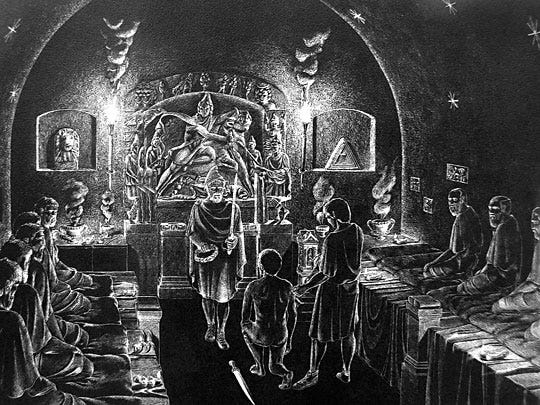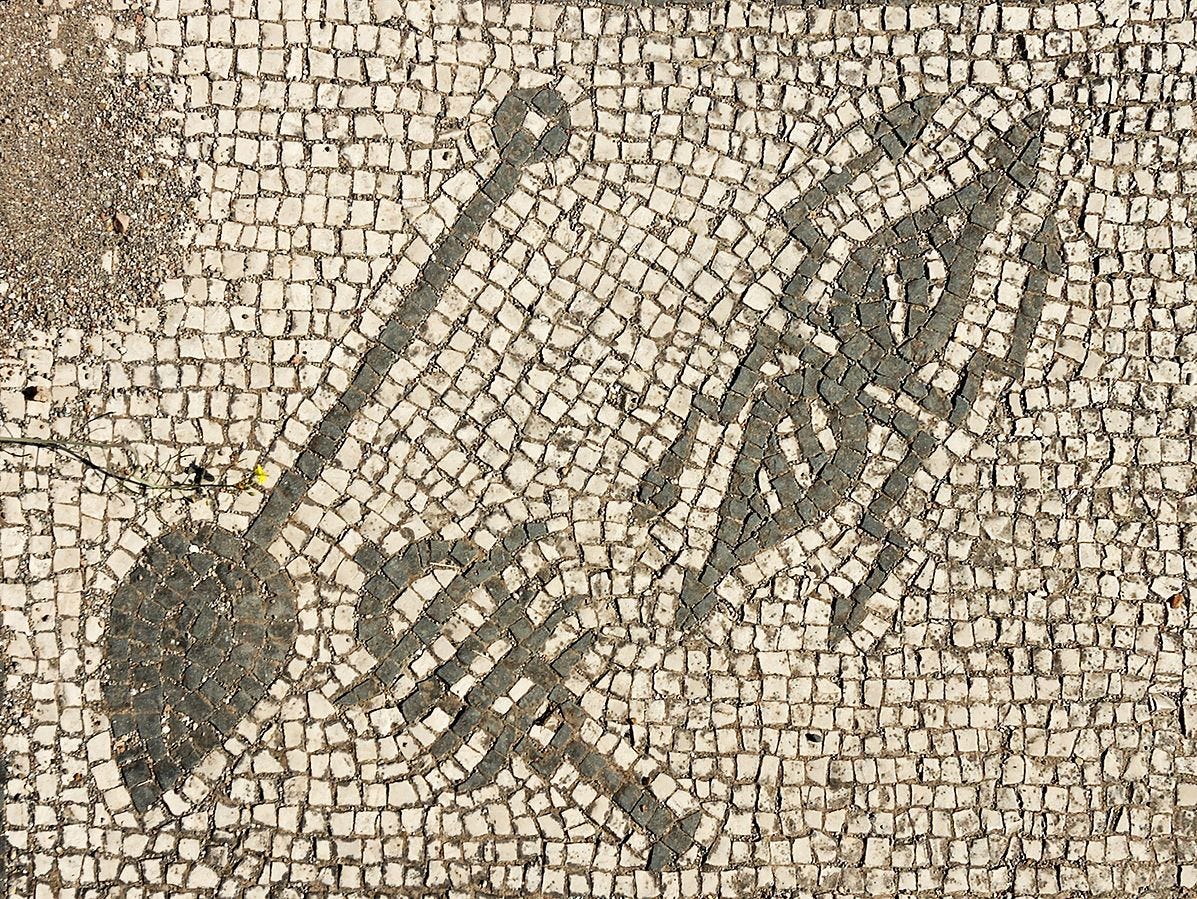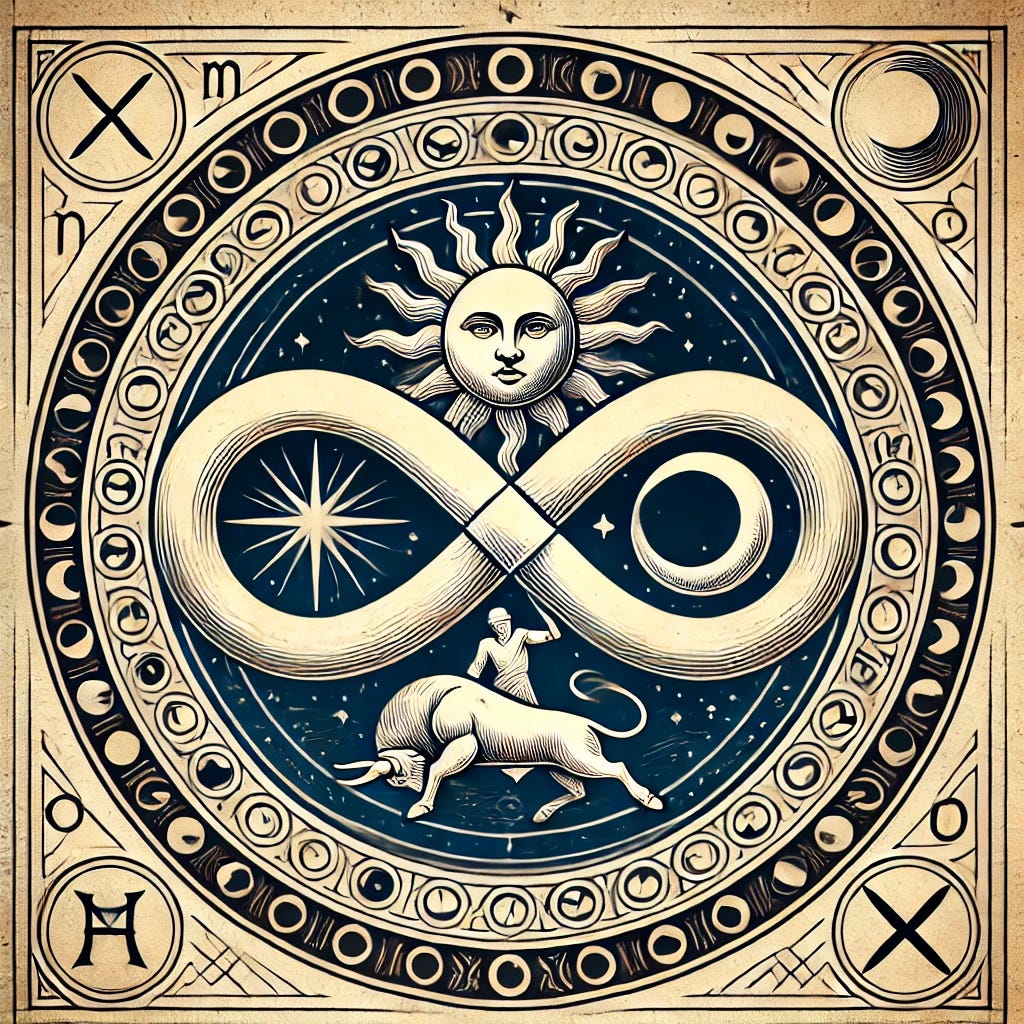Miles (Solider)
The grade of Miles, or warrior, in the Roman Mithraic Mysteries was the third step in the hierarchical path of spiritual initiation within the cult. Associated with the planet Mars, the god of war, this grade emphasized martial discipline, self-sacrifice, and readiness to serve. The symbolism and rituals of the Miles degree reflect the central values of duty, courage, and spiritual struggle, marking a pivotal transformation in the initiate’s journey.
The Miles grade drew from the long tradition of Mithras as a heroic warrior figure, the lord of wolves and warriors since the Bronze Age. The Roman legionary was the latest in the tradition of the Persian Cataphract, Vedic Charioteer, or the Yamnaya werewolf with Mithras’ name on his lip and fire in their heart as the enemy approached. With this in mind, it’s no surprise to see that Mile’s grade was heavy on military imagery, employing symbols such as a soldier's kitbag, lance, and helmet. These objects encapsulated the essence of the Miles as a soldier of Mithras. The kitbag represented the soldier’s preparedness to endure hardship and follow orders, no matter the circumstances. It contained a soldier's belongings and provisions, symbolizing the initiate’s dedication and willingness to sacrifice comfort and personal gain for a higher purpose.[1] The lance, another key symbol, represented the active, combative side of the soldier. It was a reminder of the strength and fortitude required to face external challenges and internal struggles against ego and temptation.[2]. As noted by Manfred Clauss, the helmet served both practical and symbolic roles, representing protection in the physical and spiritual battles fought by the soldier in service to the Lord of War.[3] These items collectively highlighted the Miles as a figure of discipline, duty, and courage. The rank was not limited to ordinary soldiers; dedications reveal that high-ranking officers and governors also embraced this grade, identifying themselves as humble warriors in Mithras' cosmic battle against evil.[4] The initiation into the Miles grade was transformative, signifying the initiate’s liberation from the material world and the assumption of a new spiritual identity. Payam Nabarz describes the initiation as involving a series of symbolic actions: the candidate knelt naked, blindfolded, and bound, casting off their old life. A crown, presented on the point of a sword, was offered to the initiate, who placed it briefly on their head before transferring it to their shoulder, proclaiming, “Mithras is my only crown”[5]. This act symbolized the rejection of earthly power and ego in favor of spiritual allegiance to Mithras.
The ritual also reflected martyrdom, as the sword suggested triumph and sacrifice. At the end of the initiation, some scholars suggest the candidate was branded or tattooed on the forehead, marking them as a soldier in Mithras’ cosmic army.[6] This head branding (most likely done with ash from the sacred fire, a symbolic tattoo), [7] possibly administered by the superior grade of Leo, represented spiritual transformation and the sacred fire (xarenah) associated with Mithras himself.[8] The Miles grade was not merely a reflection of military values but also a profound stage in the initiate’s spiritual development. It began an active struggle against the ego and worldly distractions. While the earlier grades as the Corax and Nymphus, focused on servitude and self-discovery, the Miles embodied a more energized and purposeful role. As Cooper notes, this degree fostered a new personality, preparing the initiate to combat evil both within and without, serving as a bulwark for the Mithraic community and its values.[9] This spiritual battle was reflected in Miles's vow of loyalty to Mithras, a god of salvific overcoming and cosmic victory. The Miles saw themselves as conscripts in a metaphysical war, tasked with upholding truth and virtue against the forces of deception and chaos, whether metaphysical or temporal.[10] Remniciment of Evola’s doctrine of inner and out holy war from the Islamic version of an older Persian warrior’s mantra.[11] The rejection of the crown further symbolized this devotion, underscoring the soldier's dependence on Mithras rather than worldly accolades, overcoming desire, and striving to serve the higher.[12]. In conclusion, the Miles grade of the Mithraic Mysteries represented a crucial stage of spiritual awakening and active service. Through its martial symbols, rigorous initiation rituals, and emphasis on self-sacrifice, the Miles transformed initiates into a soldier of Mithras. Thus, the Miles grade's themes of sacrifice, discipline, and spiritual struggle had a lasting influence, drawing from history and projecting a heroic ethos forward. It reminds us of the cosmic struggle and the eternal return that while Mithras wages against the darkness, he calls out to the initiate to don his amour and join the fight to battle the forces of darkness and uphold the values of truth and salvation. This grade exemplified the intertwining of physical discipline and spiritual growth, creating a powerful model of devotion and duty that resonated far beyond the Mithraic cult itself.
Leo (Lion)
The Mithraic grade of Leo (Lion) represents the fourth stage of initiation, marking the beginning of seniority within the cult and the initiate’s entry into the inner circle. Associated with the planet Jupiter, the constellation Leo, and the element of fire, thus the Leo grade emphasized purification, transformation, and spiritual enlightenment. Its symbols and rituals, steeped in Greco-Roman and Persian traditions, illustrate the spiritual journey toward truth and divine power. The Leo grade carried significant symbolic weight, as its tools included the fire shovel, the thunderbolt of Jupiter, and the sistrum, a rattle often linked to the worship of Isis. The fire shovel symbolized purification through fire, evoking myths where mortals were made divine by burning away their mortal parts, leaving their immortal essence intact. This motif is echoed in the graffiti from the Aventine Mithraeum in Rome: “Accept, holy Father, the incense-bearing Lions… through whom we are ourselves consumed.” Leos were expected to embody this purifying force, a conduit for divine fire to cleanse and transform both self and others.[13] The sistrum, traditionally a sacred instrument in the Isis cult, had multifaceted symbolism. It could mimic the buzzing of bees, creatures associated with souls preparing for incarnation, or the roar of a lion, affirming the initiate’s role as a vocal representative of Mithras. Additionally, it symbolized the Leo’s duty to “sound” the religion, carrying its word and guiding new initiates into the fold. Recruitment often depended on the Leos, who nominated candidates for acceptance by the Pater. [14] Fire was the element of the Leo degree, reinforcing its association with purification and transformation. Honey, symbolizing the sweetness and permanence of spiritual truth, replaced water for ritual cleansing of the hands and tongue. The use of honey, as noted by Porphyry, was deeply symbolic, linking the Leo* to fire and urging them to maintain purity in thought, word, and deed, mirroring the Zoroastrian motto of húmata, hükhta, and húvarshta. The initiation ritual for the Leo grade was both transformative and demanding. The initiate’s hands were washed with honey instead of water, symbolizing their dedication to purity and truthfulness. Honey was also placed on the tongue, signifying the commitment to honest and sacred speech. This act emphasized the moral virtue central to the grade—an active and fiery form of honesty, in contrast to passive platitudes. [15] The Leo grade also played a crucial role in the communal rituals of the Mithraic Mysteries. They organize the food and the entheogen wine for the sacred feast, a reenactment of Mithras’ Last Supper with his companions before ascending to the heavens.[16] The Lions also tended the sacred altar flame or xarenah, a duty symbolic of their role as keepers of the spiritual fire that sustained the community.[17] The Leo grade was the first in which the initiate was considered adept, having progressed beyond the earlier grades; thus, at this stage, the initiate was believed to gain occult powers, including the ability to save their soul and bypass the long journey through the zodiac’s constellations, symbolizing birth and rebirth.[18] Truthfulness was the defining virtue of the Leo grade. This moral dimension went beyond simple honesty, embodying a forceful and transformative commitment to truth. Once anointed with honey, the initiate's hands were to remain pure, never to commit a crime or engage with anything corrupt, a similar trend seen with Hindu Brahmins, Celtic Druids, and Roman Flamin. Similarly, the anointed tongue signified a lifelong dedication to truthful speech. These commitments reflected the Leo’s elevated moral and spiritual obligations within the Mithraic community.[19] The Leo grade profoundly impacted both its practitioners and the broader religious culture of the cult. The prominence of this grade in inscriptions and graffiti—second only to the Pater suggests its importance and utility within the Mithraic hierarchy in its management and ritualistic maintenance. The Leo was not only a spiritual leader to the lower members but also an active participant in the rituals and recruitment processes essential to the cult’s survival. Special rooms for Lions, such as the leonteum at Sentinum, further attest to the significance of this grade in certain Mithraic communities as a leader of the community and agent of the Pater’s will.[20] Furthermore, the emphasis on fire, honey, and purification in the Leo grade resonates with themes similar to those of other Indo-European religious traditions, such as Zoroastrianism. In conclusion, the Leo grade represented a critical stage of spiritual and moral development. Through its rich symbolism, rigorous rituals, and profound moral commitments, the Leo embodies the Mithraic ideals of purification, transformation, and truthfulness. As a senior grade within the cult, it prepared initiates for leadership roles and deeper engagement with the mysteries of Mithras by living an example of Mithraic virtue. Therefore this solidifies their place within the cosmic struggle between light and darkness as the heroic lions against Ahriman, leading the brave miles marching into the battle of this world by noble example.
Perses (Persian)
We now arrive at the Perses degree in the Mithraic Mysteries, the fifth initiation stage, representing the symbolic and mystical link between Perseus and Persian mythology. Governed by the Moon and symbolized by powerful emblems such as the sickle or harpe sword, this degree emphasized preserving spiritual purity, fertility, and the transformative destruction of lower, animalistic tendencies, the overcoming of Plato’s dark horse. The Perses degree is named after the son of Perseus, the mythological founder of the Persian race. This connection tied the acolyte to both Greco-Roman and Persian traditions.1 The symbolic framework around Perseus’ mythic role as a slayer of monsters and a preserver of order highlights Mithras’ and the Aryan archetypal struggle against dragons.2 The Moon’s association with this degree is particularly striking, diverging from its usual position as the planetary ruler of the first degree in other mystical systems. In Mithraism, however, the Moon governs Perses, reflecting a unique cosmological ordering, placing him close to the sun and thus Mithras himself.[21] The key symbols of the Perses are the crescent Moon, eight-rayed star, and harpe sword—each carried profound meanings. The crescent Moon and star represented Luna’s protection and fertility, tying the initiate to cycles of growth and preservation. The eight-pointed star, the symbol of Mithras visible in the cosmos, and the harpe sword, Perseus’ weapon against Medusa, symbolizes the destruction of base titanic instincts of desire, allowing the initiate to transcend their lower self and overcome this physical form.[22] Purification with honey, as in the earlier degree of the Leo, played a central role in the Perse’s initiation. In ancient Persian belief, honey was associated with the Moon and represented purity, preservation, and fertility. Its application during the ritual reinforced the initiate’s duty to maintain spiritual integrity and protect the “fruits” of the community—metaphorically representing the souls of its members. The symbolism of honey also reflected its connection to the Moon as a source of vitality and renewal.[23] The initiate was tasked with preserving the community’s spiritual essence, symbolized by the fruits. This role marked a transition from personal development to communal responsibility, aligning the Perses with both nurturing and martial aspects. The initiate’s use of the harpe sword illustrated this duality: the cultivation and preservation and the confrontation with the demonic to allow transcendence.[24] The harpe sword, a weapon gifted to Perseus by Hermes, was a central emblem of the Perses grade. Its presence in the initiation rituals underscored the initiate’s role in overcoming internal and external challenges. Perseus’ decapitation of Medusa served as a metaphor for severing ties with fear, ignorance, and the base self, allowing the initiate to progress on their spiritual journey. The symbolism of the harpe further tied the Perses degree to cosmic order and heroism, as Perseus’ myth was deeply ingrained in the Mithraic worldview hinting at that older Aryan sense of the chaoskampf.[25] The association with Perseus also linked the Perses grade to Mithras himself. Perseus, as a heroic figure in Greco-Roman mythology, was often identified with Mithras due to shared themes of strength, victory, and celestial guardianship. The grade’s connection to the Moon highlighted themes of fertility, cycles, and rebirth, grounding the initiate’s spiritual ascent in the nurturing and preserving forces of nature, highlighting Mithras’ role in providing the cosmic order or Asha in the face of chaos.[26] The Perses initiate was responsible for preserving the community’s spiritual health. This role extended beyond simple stewardship to encompass the spiritual guidance and protection of the souls under their care. The use of lunar and agricultural imagery reinforced the initiate’s duty to nurture and harvest spiritual growth within the Mithraic community. Additionally, the symbolic connection to Perseus suggested that the Perses initiate embodied the heroic qualities necessary to defend and sustain the community’s ideals in the face of threats and to be a moral banner to rally around in times of crisis.[27] The prominence of the Perses grade reflects the cult’s integration of Persian and Greco-Roman influences. By linking the initiate to Perseus and his son, Perses, the degree bridged mythological and historical themes, underscoring Mithraism’s syncretic nature as not Roman or Persian but as Aryan or Hyperborean in it’s orientation.[28] The combination of lunar symbolism, martial emblems, and agricultural motifs illustrated the multifaceted role of the Perses within the cult’s hierarchy. The grade’s emphasis on preservation, purity, and spiritual heroism positioned it as a critical stage in the initiate’s journey toward enlightenment and cosmic harmony.[29] The Perses degree symbolized a transformative stage of initiation, blending fertility, preservation, and heroism themes. Rooted in lunar cycles and Persian mythology, it emphasized the initiate’s role as a steward of the spiritual and communal well-being of the Mitheraeum, armed with the tools to cultivate growth and combat adversity. Through its rituals and symbols, the Perses celebrated the integration of celestial and earthly forces, guiding the initiate closer to the ultimate truths of the Mithraic tradition.
[1] Cooper 123
[2] Ibid
[3] Clauss 134
[4] Cooper 122
[5] Nabarz 34-5
[6] Nabarz 35, Jorjani 229
[7] Ruck 131, Jorjani 229
[8] Ruck 131
[9] Cooper 124
[10] Ruck 130, Cooper 123
[11] Julius Evola, Metaphysics of War, 42-5
[12] Jorjani 229, Ruck 130
[13] Cooper 125, Nabarz 36
[14] Cooper 126, Clauss 135
[15] Clauss 135, Nabriz 36
[16] Nabraz 36, Clauss 135
[17] Ibid
[18] Cooper 130
[19] Cooper 126-7, Nabarz 36
[20] Clauss 136
[21] Cooper 131-2, Nabarz 36
[22] Cooper 132-3, Clauss 136, Jorjani 206
[23] Cooper 132, Nabrz 37
[24] Cooper 134, Clauss 136
[25] Jorjani 64, Cooper 133
[26] Nabarz 36, Jorjani 207
[27] Cooper 132, Clauss 136
[28] Cooper 131-134, Nabarz 37, Clauss 136
[29] Ibid








